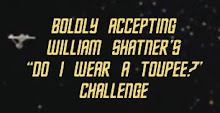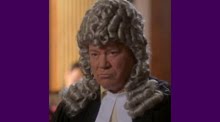In all of our attempted chronicling of Shatner's toupee, one unavoidable question seems to pop up over and over again: Why does Bill Shatner wear a toupee? On the surface, that might seem like a remarkably obvious question - "Because he is bald".
But let's try to dig a little deeper, perhaps exploring the realm of Shats' psychology, which some of you may find a step too far. And if you feel that way, then we of course understand. But in order to truly answer the question, it is important to both understand Shatner the man, and also the era during which he first emerged as a promising young actor.
 Bill Shatner acting in A Shot in the Dark, which ran from October 1961 - September 1962 (source here).
Bill Shatner acting in A Shot in the Dark, which ran from October 1961 - September 1962 (source here).During his days in the theater, Shats was already rising to prominence as a potential star. He was handsome and he was talented. There were even suggestions that he could be the next Olivier. Early on, he was even offered a contract with a major studio - he turned down the offer, feeling it would be too restricting. Shats, in typical fashion, was going to do this his way. At around this time, during the late 1950s, while Shats was only in his late-twenties, his hair started getting a little thin. So he did what most actors that aspired towards leading man status did at the time - he started wearing a hairpiece. It was a perfectly normal decision, and was even openly reported in the trade papers of the day. Did Burt Lancaster or James Stewart or Clark Gable become major stars by having thinning hair? We're not saying they had thinning hair, but the point was, if they had, would they still have been stars? That is a sad prejudice that still exists in Hollywood, albeit on a far lesser scale than it did in the 1930s, 40s or 50s.
Simply put, while so-called "character actors" could have any hair (or not) they wished, in 1950s Hollywood, there still prevailed a strong sense, with only a few exceptions, that leading men had to have a full head of hair. Now, to the psychology part.
We know that Shats' father Joe, had different plans for his son. He was to continue in the family clothing business, not go off and pursue some crazy dream of becoming an actor. The chasm was very real between the two men. Joe, reluctantly, gave up on talking his son out of his dream. Just "don't be a hanger on", he warned. Meaning, in essence, "You are going to have to take care of yourself. Don't come crawling back to me if you fail." That "hanger-on" message from his father, Shatner himself has conceded, played a strong part in Shatner's work ethic throughout his life.
Years earlier, as a small boy, Shatner wanted a dog. His father wouldn't allow it. When the young Bill brought an audience to tears performing a story about a boy losing his dog (but really only acting out his own painful feelings on the subject), he suddenly realized that the empathy which he had not been able to produce in his father for a dog, could be achieved in this bright, amazing - albeit somewhat unreal - world of acting.
Maybe for Bill, the hair was a very visual way to separate himself from his father. And perhaps the experience with the dog is why Shatner evidently loved the camera so much. Just watch the 60s Star Trek to see how he acted to the camera in a very real and even deep sense. What is going on, one might ask? And perhaps Shatner might ask, "Would the camera love a bald Shatner as much? I want to be loved!" Who doesn't?
The hair thinning, as with any man facing the same, produced something of a crisis. Was Shatner going to have to give up on his dream of becoming a leading man? Was he going to become a hanger on? Was he going to have to go back home to his bald father and resentfully say, "My genes have let me down."? No. Of course, not. The obvious solution was to wear a hairpiece, just as many, many actors did. It really wasn't such an unusual decision at all.
But then, the next logical level of "why?" becomes, why the personal use? Why was it not just a professional matter? We know that while working on Star Trek - undoubtedly a huge break for Shatner, he would still turn up to work bald and have his hairpiece attached during makeup. For Shatner, an obvious question arises: "What will the public think if they see Jim Kirk is really bald, an inch shorter and increasingly pudgy? Will they no longer like me? Will they be dissappointed?"

So, it is highly likely that during this time, Shats moved from mere professional toupee use, to public off-screen use and then gradually even to private, full-time use too. And of course, what he does behind closed doors is really his business and no-one else's.

The crux came after Star Trek's cancellation. Probably one of the worst times in Shatner's life. Not only was he suddenly unemployed, but also divorced, having to pay a very costly alimony settlement to boot. This is where the toupee years, especially for Shatner toupee watchers get a bit ridiculous. Level three of "why?" - "Why wear those absolutely silly toupees, when at this point (perhaps not before) you clearly would have looked a lot better bald? Who were you trying to fool?"

The answer perhaps lies in the story we have relayed above. Maybe for the toupee to have come off, would have been a deep and public admission that the dreams of becoming the "leading man" that Shatner (still) dreamed of becoming were truly over. The makers of the 1996 short comedy film William Shatner Lent Me His Hairpiece were perhaps touching on something that was actually profoundly far truer than they realized with their story of a magical toupee that gave the wearer special powers. For Shatner, the toupee was likely a source of strength, not weakness - a kind of comfort blanket. One also senses that Shatner has a very, very strong fear of personal humiliation. He has clearly mellowed since the 1960s, but a huge level of insecurity - some entirely natural for any actor - has always been at the surface (and was perhaps behind some of the egocentric antics that so angered the "gang of four" in Star Trek).
And the failure of the Star Trek TV series in 1969 was not the first time events had seemingly conspired against Shatner. There were several times in his early acting career when he was passed over for a film adaptation of a theatrical play that he had starred in and nurtured, including The World of Suzy Wong (1960), where he was replaced by William Holden and A Shot In The Dark, where the role went to Peter Sellers and became the Pink Panther series.
 In Star Trek, before its cancellation, Shatner suddenly experienced "Spock-mania" erupting all around him. Again, he felt he was being overlooked; his talents under-appreciated. In this case, his situation was not dissimilar to Paul McCartney's. While John Lennon was viewed as the interesting, alternative Beatle, McCartney's contributions were often overlooked. The same has invariably happened with Shatner's contribution. Indeed, Star Trek began as a leading-man-oriented series, not an ensemble piece. In summary, many of these factors added to Shatner's already heavy sense of insecurity. If the toupee came off - ever - the rest of the Trekkies would perhaps flock to Nimoy; the decisions not to go with Shatner in the two aforementioned movie adaptations might be vindicated somehow; the star would be exposed as a fraud...
In Star Trek, before its cancellation, Shatner suddenly experienced "Spock-mania" erupting all around him. Again, he felt he was being overlooked; his talents under-appreciated. In this case, his situation was not dissimilar to Paul McCartney's. While John Lennon was viewed as the interesting, alternative Beatle, McCartney's contributions were often overlooked. The same has invariably happened with Shatner's contribution. Indeed, Star Trek began as a leading-man-oriented series, not an ensemble piece. In summary, many of these factors added to Shatner's already heavy sense of insecurity. If the toupee came off - ever - the rest of the Trekkies would perhaps flock to Nimoy; the decisions not to go with Shatner in the two aforementioned movie adaptations might be vindicated somehow; the star would be exposed as a fraud...By the mid-seventies, long after the cancellation of Star Trek, was Shats in some sort of delusion? By now, the toupees were so bad that they were arguably hurting rather than helping his career. That part, we cannot speculate upon. Whether Shats knows we know, or whether he thought we didn't know. Who knows? Perhaps in his mind, the 1950s model of the Hollywood movie star was still the ultimate one. A leading man must have hair: period.
So we reach the Star Trek movie years, with far more money finally being spent on better hairpieces. As we have mentioned at this blog before, times have changed, as have attitudes to baldness. Today, no-one really cares that Nicholas Cage is bald off screen and wears a rug on-screen. It just isn't really relevant or even interesting. Perhaps part of the allure of Shatner's toupee is the eternal fascination of the secret/mystery.
But why not go part-time? How can such a charming man have this "one deep concession to vanity"; one so strong that to dare to probe the issue risks the wrath of Shatner? Of course, all that ended with George Takei's (somewhat spiteful) public outing of Shatner's toupee use during the notorious "Shatner Roast". Bill just smiled, gritting his teeth. For years, almost every review of his Star Trek movies had featured a few quips from the author with regards to Shatner's piece. He knew we knew, right?!?! Was there some sort of master plan at work? Would the toupee only be removed at a glorious moment in the future?
The older we get, the harder it is to change ways. That is a universal. Perhaps if Shatner was only emerging as an actor in the 1980s, rather than 1950s, he might have chosen the Ted Danson or Nicholas Cage part-time approach. But as it is, the decision has been made. The toupee is for all time. The decision to not create a circus (at this point it would be major news) and remove the toupee in public has been made. The only chance we may get to see Shatner bald and finally satiate our odd curiosity about this taboo is if a director were to convince Shats to play a bald character in a movie or on a TV show. Otherwise, will Shats still be wearing a toupee when he is 90, God-willing that this human dynamo is still with us? We think so. He knows we know, and we know he knows we know. And Shatner likely also knows that in the style of a true dramatist, the toupee secret, with its many twists and turns has thrilled and fascinated audiences for decades. Surely that is the mark of a true star!






















Sean Connery wore a toup in all the James Bond movies, but in other films like Robin and Marian and Man Who Would Be King he didn't. The question is if Shatner had been offered comparable roles that would have required him to perform sans hairpiece, would he have accepted them?
ReplyDeleteI'm guessing Shat would've preferred guest stints on Mannix, $10,000 Pyramid and Hawaii Five-0 where he could wear ridiculously long rugs to being forced to reveal the shine for all the world to see...
Also, as a side note, once Ricardo Montalban started wearing a toupee I don't recall ever seeing him photographed without wearing it, onscreen or off.
Shatner has had a love/hate relationship with his toupee for some time. he loved the illusion the wig could provide, but hated the prominent role in his life the toupee had achieved. The toupee had even outacted him in Star Trek IV, during the underwater scenes.
ReplyDeleteOne wonders if Shatner had embraced his baldness, he could have found different pursuits in life: namely, physical fitness. Instead, the toupees led to overeating which in turn led to corset-wearing. There is a powerful message there, somewhere.
As Shatner greets his fans, the young boy looking directly into the camera also appears to be wearing a toupee, perhaps as a sign of respect to his hero, Captain Kirk.
ReplyDeleteJimmy Stewart wore a toupee for much of his career. He didn't always wear it off the set, however. When Stweart, a veteran, was awarded a medal (by President Lyndon Johnson, IIRC) he was not wearing it.
ReplyDeleteI don't think he has a toupee anymore. I think it's hair from the back re-planted in the front after one of those flap procedures. Wouldn't take much to cover up the bald section with the grafts after that. I think he looks natural now. Star Trek wouldn't have worked without him, and Kirk wouldn't have worked if he were bald. So I'm glad he wore a piece, otherwise we wouldn't have those classic shows and films.
ReplyDeleteIt's a toupee that he wears now, but one that until just recently looked more natural than the ones he used to wear.
ReplyDeleteThis coment comes late to the party, but I think the comparisons of Shats to McCartney are brilliant and spot on... On several levels actually, since there seems to be a cult of "McCartney wore a wig" sites gathering some critical mass out there in the intertoobs. Go on and googles it. Sort of shocking to think, isn't it?
ReplyDeleteThere is no superlative strong enough to reflect how important Star Trek (TOS) and the Beatles and toupees were to the predigital 1960s, and by proxy, to our sad toupee of a pop culture today. This wonderful site has stoked my enthusiasm for the nuances and absurdities that defined that bygone era. How sadly flat our lace lines lay on our foreheads in the 21st Century.
I know this site is written with tongue planted in cheek, but I just wanted to say how much I enjoy your writing and insightful analysis not only of the hair, but of one of my favorite actors and human nature in general. Toupee! I mean Touche!
ReplyDeleteFascinating article. The Psychology of the Toup. If Shatner ever wanted therapy, he should come to you.
ReplyDeleteThere is no doubt (IMHO) that Shats wore a toupee as far back as TOS and further, but it is plain to see in recent photos that he has had plugs. They look pretty good, too. Am I the only one who thinks his pieces on TOS looked far better than any of the toupes since? Pretty amazing work by the hair/make-up people back then.
ReplyDeletehttps://giphy.com/gifs/JuliuPCRzl3cA
ReplyDeleteDo I wear a toupee?
Do I?
Jimmy Stewart, John Wayne and Gary Cooper wore toops. Cooper wore a lace net that had hair attached to it and in which his Coop's own hair was brought through and intermeshed.
ReplyDeleteFurthermore, Sean Connery was a superstar and a legend. He was the #1 box office star in North America in 1965, and the #1 box office star in the world during the height of Bondmania. He could go rugless (and was the first star of his time that did) as he had star power....
ReplyDeleteBtw, Bogie's hair started falling out in the late 1940s and he had to start wearing a toop.